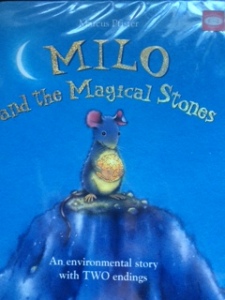Ruben’s dreams were of places that made no sense to him. Places that didn’t exist. At least not anymore.

Ruben, a young boy lives on the outskirts of a damaged, abandoned and futuristic city. Every day when he wakes he writes about his dreams and flicks through images of places he once knew.
Living alone, Ruben often wanders the streets, avoiding the huge machines that live in Block city who destroy things humans need for survival – freedom, safety and knowledge.
One day, on his way through the city in search of food and water, he discovers Koji, another child who is also alone. Together they understand each other, share secrets and dream of escaping on one of the fast trains that leave the destroyed city.
Bruce Whatley is a master illustrator who has created this whole world in black and white – giving it the grim and abandoned feel it needs. Readers will pour over the illustrations for hours as they journey with Ruben hoping that he can escape this formidable place.
Although set in the future, the sketches of objects Bruce Whatley has included, pull on our own heart strings and lead us to think – what if? Children of all ages will ponder the possibility of places in our world that already look like this or the possibly of our own country looking like this if we don’t care for others around us.
This Dystopian world that Ruben lives in is one that young children can enter without the violence of many other Dystopian fiction books on the market.
I have explored this book with some Gifted Year 4 students and they have thoroughly enjoyed learning more about Ruben and then creating a Dystopian world of their own.
So what can you do?
GRASPS Task – – Ruben by Bruce Whatley
GOAL: You are going to create your own dystopian world using as many as the key areas as you can.
ROLE You are the engineer of this futuristic society. You are the designer of the people, their plight and their place.
AUDIENCE You need to create a world that will appeal to readers aged 8-12. .
SITUATION : In the book market there are many fiction books set in Dystopian worlds but they are for older readers and any are full of violence. You need to create a dystopian world without violence. There are many other ways the world can become dystopian so use your create juices and move away from the violence we hear about in the older books.
PRODUCT. The world you create needs to be a combination of things so we can get a true insight into this world. You can use: Diary entries, maps, posters, sketches, storytelling, newspaper articles, radio correspondence etc.
You will be marked out of 15.
STANDARDS and CRITERIA [INDICATORS]
| 1 | 2 | 3 | |
| Key areas of a dystopian world. | Student has used 3 key areas in their dystopian world | Student has used 5 key areas in their dystopian world | Student has used 6 r more key areas in their dystopian world. |
| Understand how texts vary in complexity and technicality depending on the approach to the topic, the purpose and the intended audience (ACELA1490 | Student has developed three different types of texts to engage the audience | Student has developed four different types of texts to engage the audience | Student has developed five or more different types of texts to engage the audience |
| Discuss how authors and illustrators make stories exciting, moving and absorbing and hold readers’ interest by using various techniques, for example character development and plot tension (ACELT1605 | Outline how they developed characters and settings briefly. | Outline how they developed characters and settings in details. | Outline how they developed characters and settings in detail and respond to questions with good explanation. |
| Create literary texts by developing storylines, characters and settings (ACELT1794 | Outline the basic process of creating this Dystopian world. | Discuss how characters were developed and how they fit into the world created. | consider how and why particular traits for a character have been chosen. Discuss in details why the setting has been created and how the idea was developed. |
| Plan, draft and publish imaginative, informative and persuasive print and multimodal texts, choosing text structures, language features, images and sound appropriate to purpose and audience (ACELY1704 | Many errors made in final draft with little editing present. | Some mistakes made in final products wth some editing present. | Excellent final product with little or no mistakes. |


